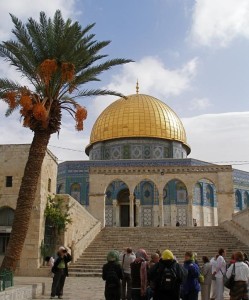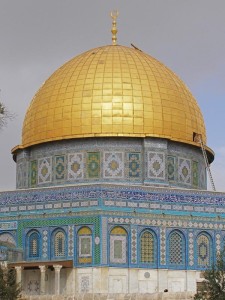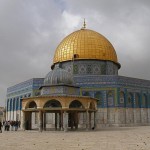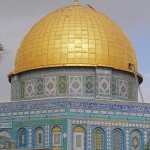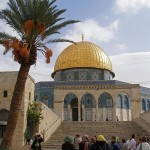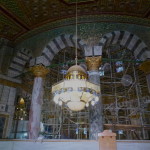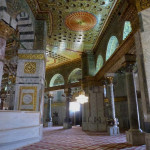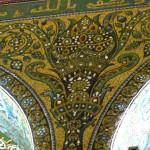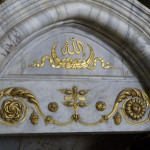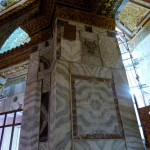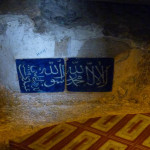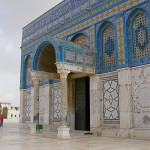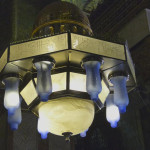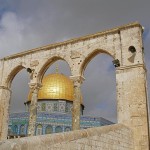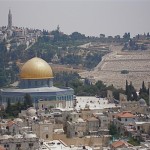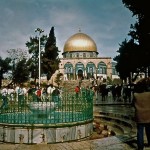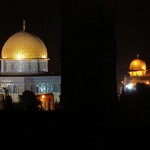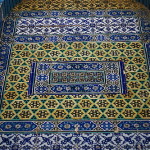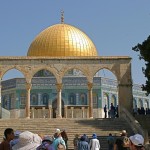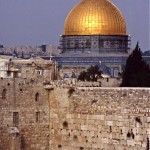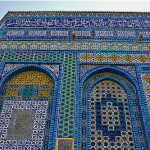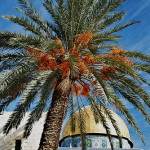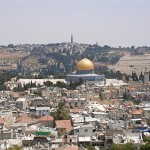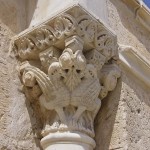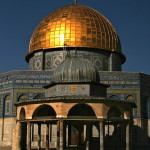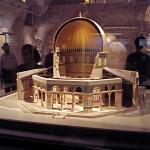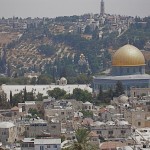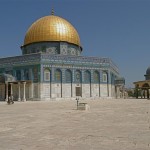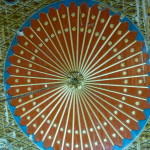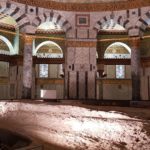Jerusalem
Jerusalem’s iconic symbol is the gleaming Dome of the Rock, whose golden roof has dominated the Temple Mount for centuries. This Islamic holy place stands on a site that is sacred to Jews, Christians and Muslims.
• To Jews, this is where Abraham, in a supreme act of faith, prepared to offer his son Isaac on Mount Moriah. It is also the place where the Temple once stood.
• To Christians it is where the baby Jesus was presented in the Temple; where he was found among the teachers as a 12-year-old; where he later prayed and taught — and drove the money-changers out of the Temple precincts. For most of the 12th century, when the Crusaders controlled Jerusalem, the Dome of the Rock was actually a Christian church.
• To Muslims the Dome covers the sacred rock where Muhammad prayed and went to paradise during his Night Journey from Mecca to Jerusalem and back to Mecca on the winged steed called Al-Burak.
The Dome of the Rock was the first major sanctuary built by Islam. Although it is sometimes erroneously called the Mosque of Omar (a companion of Muhammad) it is actually not a mosque but an adjunct to the nearby Al-Aqsa Mosque.
Ornamentation by Christian artists
A building of extraordinarily harmonious proportions, the Dome of the Rock is 20 metres across and more than 35 metres high. It was commissioned by Caliph Abd al-Malik and completed in AD 691. Its rich ornamentation was the work of Syrian Christian artists.
The roof is covered with gold-plated anodised aluminium. Inside, the sacred rock is protected by a 12th-century cedar wood screen. Crosses on some of the columns show that they were taken from churches. A high reliquary beside the rock is believed to contain a hair of Muhammad’s beard.
On the southern side of the rock, steps lead down to an ancient cave, known as the Well of Souls, to which many Jewish and Islamic legends are attached. The Crusaders used the cave as a confessional.
Current Arab tradition suggests that Caliph Abd al-Malik built the Dome to commemorate Muhammad’s Night Journey and ascension to paradise.
Older sources indicate that the caliph’s purpose was two-fold: 1) to emphasise the superior truth of Islam over both Judaism and Christianity; 2) to outshine the splendour of Christian churches.
A 10th-century account says he was concerned that the Church of the Holy Sepulchre might “dazzle the minds of Muslims”. The dimensions of the iconic golden dome match those of the Holy Sepulchre’s dome.
Challenge to Christians
The Dome’s “founding inscription” runs for 240 metres in a single line of Kufic script (the oldest Arabic writing in existence) along the top of both sides of the inner octagonal arcade.
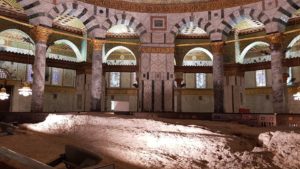
The sacred rock inside the dome (© Marie-Armelle Beaulieu)
In a clear challenge to the Christian belief in the Trinity and the divinity of Jesus, it says:
“O you People of the Book, overstep not bounds in your religion, and of God speak only the truth. The Messiah, Jesus, son of Mary, is only an apostle of God . . . . Believe therefore in God and his apostles, and say not ‘Three’. It will be better for you. God is only one God. Far be it from his glory that he should have a son.”
By building the Dome of the Rock, Caliph Abd al-Malik symbolised the transformation of Jerusalem — once a Jewish city, then a Christian city — into a Muslim city. Today, of course, the city is both culturally and religiously diverse.
Related site:
Administered by: Islamic Waqf Foundation
Tel.: 972-2-6226250
Open: Non-Muslims are permitted to enter the Temple Mount through the Bab Al-Maghariba (Moors’ Gate), reached through a covered walkway from the Western Wall plaza, during restricted hours. These are usually 7.30-11am and 1.30-2.30pm (closed Fridays and on religious holidays), but can change. Modest dress is required. Non-Muslims are not normally allowed into the Dome of the Rock or the Al Aqsa Mosque. Non-Muslim prayer on the Temple Mount is not permitted.
- Dome of the Chain beside Dome of the Rock (Seetheholyland.net)
- Close-up of Dome of the Rock (Seetheholyland.net)
- Temple Mount visitors at Dome of the Rock (Seetheholyland.net)
- Scaffolding covering the holy rock during restoration work in 2013 (Seetheholyland.net)
- Inner ambulatory surrounding the holy rock in Dome of the Rock (Seetheholyland.net)
- Mosaic decoration in Dome of the Rock (Seetheholyland.net)
- Archway over stairs leading to cave under Dome of the Rock (Seetheholyland.net)
- Marble column in Dome of the Rock (Seetheholyland.net)
- Islamic inscription in cave under Dome of the Rock (Seetheholyland.net)
- An entrance to the Dome of the Rock (Seetheholyland.net)
- One of several octagonal light fittings in Dome of the Rock (Seetheholyland.net)
- Arches where Muslim tradition says scales to weigh souls will be hung at the Last Judgement (Seetheholyland.net)
- Dome of the Rock and Jewish cemetery (right) on the Mount of Olives (Seetheholyland.net)
- Temple Mount and Dome of the Rock (© Israel Ministry of Tourism)
- Dome of the Rock and Al-Aqsa Mosque (right) by night (Seetheholyland.net)
- Closeup of Iznik tiles added to the Dome of the Rock by Suleiman the Magnificent (Brian Jeffery Beggerly)
- Steps leading up to the Dome of the Rock (© Tom Callinan / Seetheholyland.net)
- Dome of the Rock and Western Wall (© Israel Ministry of Tourism)
- Colourful tiles on the Dome of the Rock (Ana Ulin)
- Palm tree at the Dome of the Rock (Clare Jim)
- Temple Mount and Dome of the Rock with the Mount of Olives in the background (Seetheholyland.net)
- One of the sculpted capitals of the Dome of the Rock (© Custodia Terrae Sanctae)
- Dome of the Rock and Dome of the Chain (Brian Jeffery Beggerly)
- Model of Dome of the Rock in the Tower of David Museum (Seetheholyland.net)
- Dome of the Rock with the Mount of Olives in the background (Seetheholyland.net)
- Dome of the Rock (© Tom Callinan / Seetheholyland.net)
- Ceiling design in Dome of the Rock (Seetheholyland.net)
- The sacred rock inside the dome (© Marie-Armelle Beaulieu)
References
Hope, Leslie: “The Dome of the Rock”, Holy Land, summer 1999
Brownrigg, Ronald: Come, See the Place: A Pilgrim Guide to the Holy Land (Hodder and Stoughton, 1985)
Doyle, Stephen: The Pilgrim’s New Guide to the Holy Land (Liturgical Press, 1990)
Freeman-Grenville, G. S. P.: The Holy Land: A Pilgrim’s Guide to Israel, Jordan and the Sinai (Continuum Publishing, 1996)
Inman, Nick, and McDonald, Ferdie (eds): Jerusalem & the Holy Land (Eyewitness Travel Guide, Dorling Kindersley, 2007)
McCormick, James R.: Jerusalem and the Holy Land (Rhodes & Eaton, 1997)
Murphy-O’Connor, Jerome: The Holy Land: An Oxford Archaeological Guide from Earliest Times to 1700 (Oxford University Press, 2005)
Wareham, Norman, and Gill, Jill: Every Pilgrim’s Guide to the Holy Land (Canterbury Press, 1996)
External link

